Author

Renewable Energy Industry in India – A Path towards Sustainability
Abstract
India, the 2nd largest populated country and one of the exceptional performers of the global economy has witnessed significant growth in the recent years. However, with the expanding economic activities, the growing energy demand of this nation is mostly met by the conventional or non-renewable energy sources like coal, oil, natural gas etc. This practice of the Indian economy has degraded its environmental condition, caused the scarcity of natural resources and increased the financial burden.
For the transformation of the economy to a sustainable one, it is important to aim for a green economy by significantly reducing the pollution level. This is why promoting the concept, generation and usage of renewable energy in India has achieved massive importance in the recent years. Multiple initiatives, government policies and investments etc. have made India one of the attractive renewable energy markets in the world. The expansion of the renewable energy industry in the country will strengthen the energy security, control the climate risk, ensure accessibility of affordable energy to all and help to achieve sustainable economic development.
The article attempts to study the reasons behind the growing need of renewable energy in Indian economy, explores the ways through which the non-conventional energy sources will benefit the country in the long run. It also reveals the energy landscape in India, the efforts and initiatives which are being taken to encourage the growth of the renewable energy industry in the country, the challenges which are faced while the expansion of renewable energy projects and suggests way-outs for achieving a better growth path for the industry.
Introduction
The renewable energy depicts as the green energy where the energy is extracted from the sources like sunlight, wind, water which are considered to be abundant or endless. The growing level of environmental pollution, increasing temperature, rising number of natural calamities and many more events of natural disasters demand the greater use of sustainable energy which can meet the energy need of any economy without depleting the natural resources like coal, natural gas or oil etc.
Before discussing about the status of energy consumption in India, it is important to understand the global status for the same. It will help to understand the energy usage pattern of India from the global perspective to some extent.
A Glimpse of the Global Energy Sector
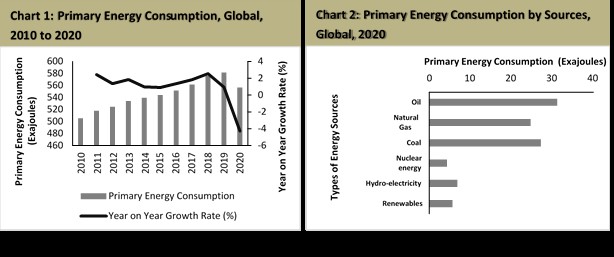
The global primary energy consumption had increased at the CAGR of 0.97% between 2010 to 2020. During this 11-year period, the yearly growth rate of the energy consumption was maximum in the year 2018 with 2.55% (Chart – 1). Globally, the energy consumption process is still mainly dominated by the non-renewable energy sources. In 2020, the shares of Oil, Coal and Natural Gas were 31.21%, 27.2% and 24.72% respectively in the overall global energy consumption (Chart -2).
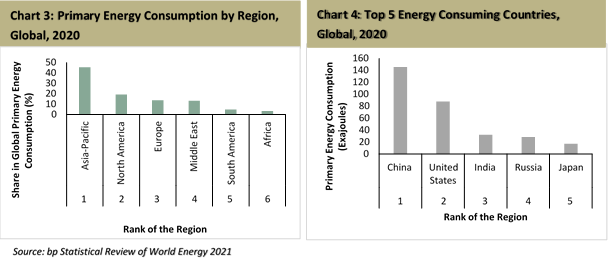
Between 2010 to 2020, the energy consumption level had increased the most in Asia Pacific. The share of this region in the overall global energy consumption increased from 38.89% to 45.5% while the European region witnessed the maximum fall (from 17.53% to 13.86%) for the same during the mentioned time period (Chart -3). Besides, countries from the Asia-pacific region also occupied the majority positions in the top 5 energy consuming countries in the world in 2020 (Chart – 4).

- Between 2010 to 2020, the CO2 emission had increased at the CAGR of 0.31% globally. In 2019, among all the non-renewable energy sources, coal, oil and gas had the shares of 39.41%, 33.9% and 20.9% respectively in the overall global CO2 emission.
- This is why, a slow but steady movement towards the consumption of the renewable energy sources can be witnessed in the different parts of the world in the recent years (Chart – 5).
Key Features of the Global Energy Sector in the Recent Years
- The global energy sector has always been depending upon the non-renewable energy sources which are mainly dominated by the fossil fuels like coal, oil and gas. The extreme usage of fossil fuels for decades has triggered the rapid exhaustion of the global carbon reserves.
- Burning such kind of fuels release Carbon-dioxide (CO2) in the atmosphere which leads to widespread air pollution and affects the global climate. Though in the recent time, the demand for the renewable energy generation has increased but the greater usage of fossil fuels is still there and the demand of such fuels is also expected to grow significantly in 2021. These all things have caused the global carbon emissions to jump by 1.5 billion tonnes this year.
- Continuity of such incidents for decades led governments, businesses, investors and the public to recognize the need to decarbonize the global economy. Reshaping the energy usage pattern has been the prime agenda for many countries in the recent years.
- The 21st Paris Climate Conference was held in 2015 where the “Paris Agreement”, the landmark international treaty on climate change was adopted by 196 countries in Paris on 12 December 2015. The central aim was to limit global warming to well below 2, preferably to 1.5 degrees Celsius, compared to pre-industrial levels.
- Hence, the global energy system requires to bring a significant transformation, replacing the present system that is largely based on fossil-fuels. Based on the current global energy consumption pattern, it can be said that fossil fuels such as oil, natural gas and coal would continue to dominate the global energy sector for many more decades. Hence, the phase of that transition would definitely be longer.
- A path towards achieving the low carbon economy requires rapid deployment of renewable energy. With the implementation of appropriate policies, it would be possible to achieve 90% reduction in energy-related emissions in cost-effective ways and at the necessary speeds.
- After witnessing a contraction of 4% in 2020, the global energy demand is set to increase by 4.6% in 2021. A significant level of demand growth has been estimated from the developing economies and emerging markets.
- In 2020, the demand for renewables grew by 3% and is expected to grow across all key sectors including power, heating, industry, transport etc. in 2021. In the recent years, renewables have emerged as the fastest growing energy source in many countries. Among these, solar energy and wind power are undergoing very rapid growth, while the others are growing more gradually.
- Various nations have set their targets and have started taking steps to fasten their deployment of renewable energy in the recent years. To achieve the sustainable goals of “Paris Agreement”, it is important for all the countries to launch specific policies and implement these all accurately for reducing greenhouse gas emissions, control multiple environmental degrading factors and increase investment for preserving a low carbon future. Countries like Sweden, Denmark, Finland, France, New Zealand etc. have shown remarkable progress in controlling the greenhouse gas emissions in the environment by implementing appropriate clean energy initiatives.
- Many countries largely depend on the energy imports for having lesser range of oil and gas reserves in their own territories. Hence, such countries definitely need to shift their energy usage pattern towards the renewables. This is why many developing countries including India have set ambitious renewable energy targets for enhancing the environmental sustainability.
The Status of the Indian Energy Sector
India, the 2nd largest populated country is also the 3rd largest energy consumer in the world. This exceptional performer of the global economy has witnessed remarkable growth in various spheres. Between 2010 to 2020, the nominal GDP of India had increased at the CAGR of 4.72%. The share of India in the global GDP also increased from 2.58% to 3.2% between 2010 to 2020.
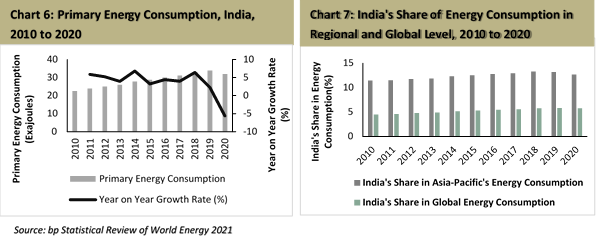
The primary energy consumption had increased at the CAGR of 3.59% in India between 2010 to 2020 (Chart – 6). The share of India in the overall energy consumption of the Asia-pacific region had increased from 11.43% to 12.63% between 2010 to 2020 while the share of the country in the global energy consumption level had also grown from 4.45% to 5.75% between the same timeframe (Chart – 7).
Hence, the energy demand of such rapidly growing economy is really huge. Growing population, rapid industrialisation, expanding infrastructural operations, widespread agricultural activities, technological upgradation in various sectors, rising rate of urbanisation, greater accessibility of electrification in the rural and remote areas etc. are some of the crucial reasons for exorbitant energy demand in the country. These all things make the growth of the Indian energy sector really promising.
The Energy Usage Pattern in Indian economy
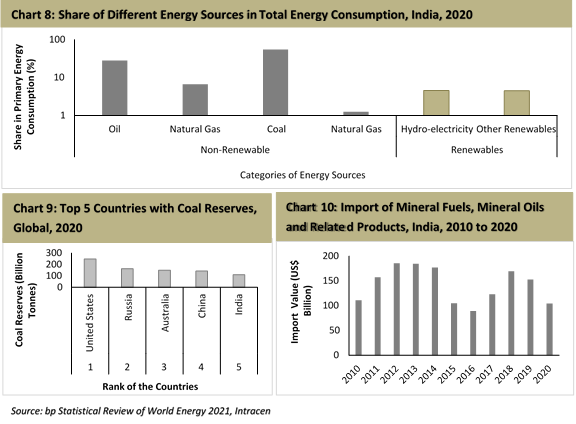
Key Findings of the Energy Usage Pattern in India
- Just like the global sector, India has also been majorly depending upon the conventional or non-renewable energy sources like coal, oil etc. for years. Despite their characteristics of emitting carbon in the environment, these energy sources have been massively used because of their easy availability and power generating features at comparatively lower prices.
- The accessibility of non-renewable resources is limited. A massive amount of fossil fuels has been stored underground for millions of years however these are being used up quicker since the hour of modern industrial revolution.
- Energy is created from these sources by burning the fuels which discharge carbon dioxide and other unsafe particles. This process affects the carbon balance in the climate, causes extreme contamination and rising global temperature. According a report published in 2020, India is estimated to bear US$150 billion annually, the third highest costs from fossil fuel air pollution worldwide.
- Besides, almost all the time, a lot lesser amount of energy is released after burning significant portion of fuel. This is the reason these sources can’t be completely used.
- Extraction process of such fuels (eg. Coal, Oil) through mining or drilling are still very much hazardous. The methods can cause severe injuries or fatal diseases to the labourers who are associated in the extraction procedures of such fuels.
- Among all the other fossil fuels, the availability of the coal has always been abundant in India. This is why the usage of the coal has also been greater in the country to meet most of the energy needs. In 2020, 55% of the primary energy consumption was acquired by coal in India (Chart – 8). India has the 5th largest coal reserves in the world (Chart – 9). However, multiple issues like land acquisition, infrastructural disadvantages, environmental clearances, insufficient investment, lesser availability of coal with high carbon content etc. act as crucial obstacles to utilise the existing coal reserves properly. Hence, it makes the country depending on importing coal from other countries too.
- Moreover, due to lack of adequate petroleum reserves, India has to depend mostly on crude oil imports and oil import in the country has been steadily rising over the years. Any issues in the geo-political factors impact the price of such fuel (eg. Oil) massively. It causes many countries to pay huge amount of bill for importing the fuels to satisfy their energy needs. In 2020, the India’s import value for Mineral Fuels, Mineral Oils and Related Products was US$ 104.36 Billion and it was 28.4% of India’s total import value in that year.
How the Greater Use of Non-renewable Energy Sources is Impacting Indian Economy
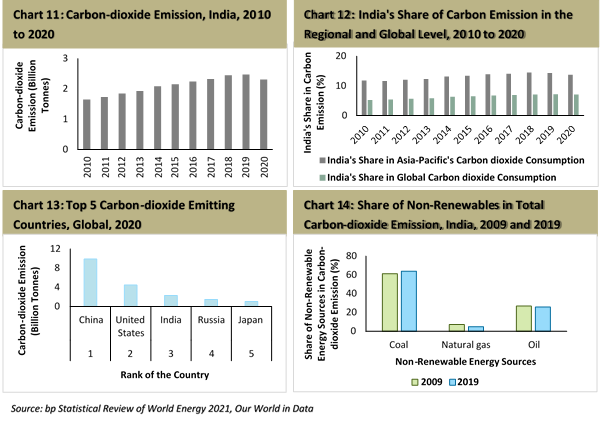
- Economic growth is desirable for any country and the rising energy demand is proportional with that growth. India, the 2nd largest populated country in the world has grown significantly in various spheres in the recent years. The country also expects to make major leaps in its development in the coming decades and it will definitely require more energy than India currently consumes.
- Features like rapid industrialisation, urbanisation, rising number of vehicles, poor emission control technologies etc. produce greenhouse gases and other types of harmful gases in the environment massively.
- Greenhouse gases (eg. carbon dioxide, methane, nitrous oxide etc.) are also known as heat-trapping gases which create heat-reflective layer around the earth and keeps the atmosphere warmer than it would be without them. Initially the presence of them was definitely helpful to create a liveable temperature.
- However, as mentioned, the faster rate of disruptive activities is causing rise of greenhouse gases in the environment at an alarming rate resulting unwanted rise in global temperature. The increase in global temperature is impacting the rainfall, wind patterns, ocean currents and ecological balance.
- Carbon dioxide is said to be responsible for 60% of the “greenhouse effect” in the world. Between 2010 to 2020, the carbon dioxide emission in India had grown at the CAGR of 3.37% (Chart -11).The share of India’s carbon emission in the regional (Asia-pacific) and global level were 13.72% and 7.13% respectively in 2020 (Chart -12). Not only this, India was also the 3rd largest Carbon-dioxide emitter in the same year (Chart -13).
- In 2019, the shares of Coal, Oil and Natural gas in the Carbon-dioxide emission were 63.81%, 25.72% and 4.92% (Chart – 14) in India. Based on the energy usage pattern of the Indian economy, it is expected that by 2050, 65% of India’s energy demand might be met by fossil fuels.
- Continuity of such incidents is making the country face adverse environmental impacts with a changing climate, including rising sea levels, melting glaciers, worse heat waves, droughts, cloudbursts, floods, degraded coastline, stronger cyclones and many other extreme weather events.
- According to a recent report prepared by the experts of Pune-based Indian Institute of Tropical Meteorology (IITM) – India’s average temperature has risen by around 0.7 degrees Celsius during 1901–2018, the sea level has risen by 3.3 mm per year between 1993 and 2017, Sea surface temperature (SST) of the tropical Indian Ocean has risen by 1 degree Celsius on average during 1951–2015, and the summer monsoon precipitation (June to September) over India has declined by around 6% from 1951 to 2015, with notable decreases over the Indo-Gangetic Plains and the Western Ghats.
- In 2020, the eastern parts of India faced devastating Cyclone Amphan. The worth of financial damages caused by this disaster was $14 billion.
- Just like the different other parts of the world, rapid changes in the climate caused by the emission from the fossil fuels will affect the agricultural production, food-water-energy security, public health, biodiversity in India. In the absence of controlled measures, like not reducing the dependence on fossil fuels or not encouraging the usage of renewable energy sources will ultimately impact the climate change which will hinder the country to maintain the economic growth and preserve the ecosystem in the long term.
After witnessing such hazardous impacts, have there been any kinds of initiatives to encourage the usage of renewable energy sources in India?
- Expansion of clean energy sector in India, 3rd largest emitter of carbon dioxide will help in tackling climate change and reduce the consumption of fossil fuels.
- As a significant emerging nation, India has innumerable priorities to sustain its economic growth and preserve the environment before the situation becomes too vulnerable. To establish a low-carbon economy, the Indian government is committed to arrange multiple initiatives to promote renewable energy to control the climate change.
Some of the initiatives in India to achieve short- and long-term climate goals are as follows:
- A target of installing 175 GW of renewable energy capacity by the year 2022, which includes 100 GW from solar, 60 GW from wind, 10 GW from bio-power and 5 GW from small hydro-power.
- Proposal to launch ‘National Hydrogen Mission’ with the aim to generate hydrogen from green power sources.
- Initiative to set up 5,000 compressed bio-gas plants to turn municipal and agriculture waste into energy by 2023.
- Encouraging the use of energy-efficient LED bulbs with an agenda to save 38 million tonnes of carbon emission.
- India’s headline Paris pledge was to reduce the emission intensity of its gross domestic product (GHG emissions per unit GDP) by 33-35% over 2005 levels by 2030.
- India’s NDC (NDC or Nationally Determined Contributions are non-binding national plans highlighting climate actions, including climate related targets for greenhouse gas emission reductions, policies and measures governments aim to implement in response to climate change and as a contribution to achieve the global targets set out in the Paris Agreement.) also committed to ensuring that 40% of its installed power capacity is from non-fossil sources (renewable, hydroelectric and nuclear) by 2030.
- Procurement of Renewable energy through development of Inter-State Transmission Systems.
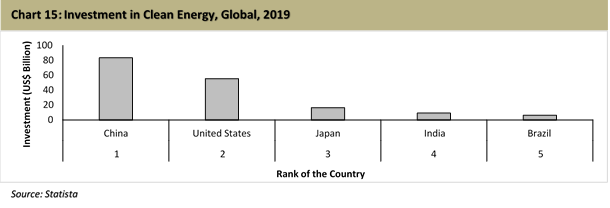
- In 2019, India was the 4th largest investor for clean energy with US$ 9.3 Billion dollars (Chart – 15).
- In the past 7 years, US$ 70 billion has been invested in renewable energy sector across the country.
- Allowing 100% FDI through automatic route. Between April 2000 and December 2020, Non-conventional energy sector received FDI inflows of US$ 9.83 billion in India.
With the launch of such types of initiatives, has the energy usage pattern in India changed? What is the status of renewable energy Industry in India?
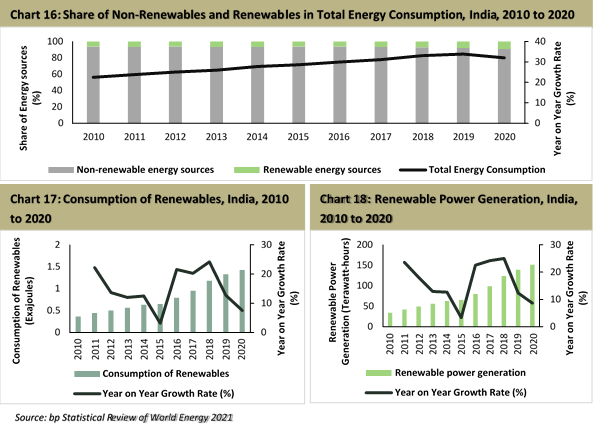
- The energy usage pattern in India has changed slightly in the recent years. Between 2010 to 2020, the consumption of non-renewables and renewables had increased at the CAGR of 3.07% and 7.96% respectively in the country (Chart – 16). So, the growth of the consumption of the renewables has been greater than the non-renewables during this time period.
- Moreover, the shares of both the categories of energy sources have also been transformed. The share of non-renewables in the overall energy consumption in India had decreased from 94.06% to 90.88% between 2010 to 2020. In case of renewables the share had increased from 5.94% to 9.12% during the same period.
- The consumption of the renewables had increased at the CAGR of 14.79% between 2010 to 2020 (Chart – 17).
- The yearly growth of this consumption was maximum in 2018 with 24.21%.
- The consumption of the renewables in the Asia-pacific region and in the world had increased at the CAGR of 20.28% and 12.66% respectively between 2010 to 2020.
- The share of India in the global consumption of renewables also increased from 3.74% to 4.51%during the same time period.
- The renewable power generation of India had increased at the CAGR of 16.13% between 2010 to 2020 (Chart – 18)
Glimpse of the Renewable Energy Infrastructure
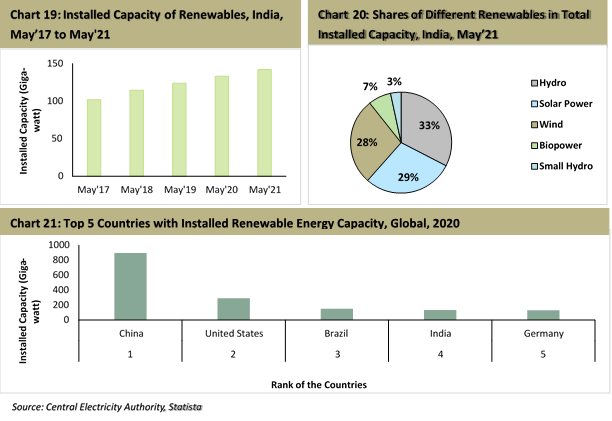
- Till May’21, India became able to have 141.9 GW of installed capacity of Renewable Energy.
- The installed capacity of renewables had increased at the CAGR of 8.64% in India between May’17 to May’21 (Chart – 19).
- In May’21, the share of hydropower was maximum in overall installed capacity of renewables in India with 33% (Chart – 20).
- However, the share of solar energy in the total installed capacity of renewables had increased the maximum (from 12.07% to 28.96%) between May’17 to May’21.
- The share of renewables in the total installed capacity of power generation had increased from 30.84% to 37% between May’17 to May’21. Whereas, the share of non-renewables had decreased from 69.16% to 63% during the mentioned period.
- In 2020, India had the 4th largest installed capacity for the renewable energy in the world (Chart – 21).
A few examples of the expansion of renewable energy projects in India
- The Cochin international airport, Kerala, India is the world’s first airport to fully run-on solar power. In Jan’21, it also commissioned a floating solar project of 452 Kwh capacity in Kerala, India.
- India’s largest energy generation park in Gujarat is spread over 72,600 hectares and has separate zones for the production and storage of wind and solar energy is expected to generate 30 GW of green energy.
- A 600 Megawatt floating solar project is being constructed in Madhya Pradesh, India with an estimated investment of $410 Million. The project is set to begin power generation by 2022-23.
Hence, there have been multiple initiatives by the Indian government which are encouraging the expansion of renewable energy industry in India. How the effective usage of renewable energy sources can help the Indian economy in the long run?
The Indian economy is on a verge to be a $5 trillion economy by 2024-25. The rapid economic growth in the recent years has benefitted the nation in various ways. However, the degrading environmental performance has also affected the country during this period.
According to “Environmental Performance Index” prepared by Yale University and Columbia University in collaboration with the World Economic Forum, India ranked 168 out of 180 countries in terms of overall environmental quality in 2020. This lower rank of the country can only be improved by reducing the Greenhouse gas emission, cleaning up the air and making significant efforts to conserve the biodiversity. Hence, the biggest challenge of the Indian economy would be to plan strategies to achieve economic growth by adopting a green perspective and implementing environment-friendly initiatives. By promoting the sustainable growth, India will be able to achieve the ambitious goal without compromising the ecology of the country.
The effective usage of Renewable energy sources significantly contributes to reduce the emission of greenhouse gases along with having several socio-economic advantages when compared to carbon-based fossil fuels. Some of the advantages for using renewable energy sources in the economy are as follows:
1) Availability of the renewable energy sources- The renewable energy sources like strong winds, sunlight, fast-moving water etc. are considered to be abundant. Most parts of India, receive huge amount of solar radiation. The country receives around 5,000 TWh of solar insolation every year. If it can be utilized with proper strategies, it can address the entire energy deficit problem in the country. According to National Institute of Wind Energy (NIWE), the total wind energy potential is 302 GW at a 100-meter hub height in India. India is blessed with a coastline of about 7600 km surrounded by water on three sides and has good prospects of harnessing offshore wind energy and tidal energy. Moreover, with an enlarged river system, India has an estimated hydropower potential of 1,45,320 MW, excluding small hydro projects (SHPs). Hence, if India starts generating power by renewable energy sources, then it will not have to depend on other countries, and energy imports will also reduce.
2) Lower Tariff Rate – Renewable energy is accessible at affordable rate electricity across the country and can help stabilize energy prices in the future. In 2020, the solar tariff in India roamed between INR 2/kWh to 3/kWh (US$ 0.027/kWh to 0.040/kWh)
3) Low Carbon Emission – The carbon emission for using renewable energy sources is much lesser than using fossil fuels. Coal emits between 1.4 and 3.6 pounds of CO2e/kWh. Wind, on the other hand, is responsible for only 0.02 to 0.04 pounds of CO2e/kWh on a life-cycle basis; solar 0.07 to 0.2; geothermal 0.1 to 0.2; and hydroelectric between 0.1 and 0.5.Even when including “life cycle” emissions of clean energy (ie, the emissions from each stage of a technology’s life—manufacturing, installation, operation, decommissioning), the global warming emissions associated with renewable energy are minimal. Hence, increasing supply of renewable energy will help to reduce carbon emissions in India.
4) Economy growth and Greater Investment – Greater usage of renewable energy will have a positive effect in the economic growth of the country. With the government’s aspiring targets for the green energy sector, India has become very attractive from investors’ point of view, both domestic and foreign, and would continue to generate more investment in the future, resulting boosting the economic performance of the country. Between April 2000 to March 2021, the non-conventional energy sector in India received US$ 10,022.72 Million.
5) Job creation – The job creation process through the renewable energy industry can definitely be a game changer in the Indian economy. The renewable energy industry is more labour-intensive compared to the thermal industry (fossil fuels) which are mainly mechanized and capital intensive. The industry is capable to produce significant number of jobs in urban as well as rural areas with the skilled, unskilled and semi-skilled workers. The solar, wind and other types of renewable energy generation procedures require large number of workers for installation, maintenance, power generation and operational activities. According to a report by the International Renewable Energy Agency (IRENA), the renewable energy industry in India accounted for almost 7,19,000 jobs in the year 2018.The further expansion of the renewable energy sector would lead to the emergence of new employment opportunities in the country.
6) Lesser dependence on carbon-based fossil fuels – Exploring the energy generation techniques from various types of renewable energy sources will definitely be a sustainable alternative for the nation and will help to reduce dependence on carbon-based fossil fuels which cause huge level of carbon emission in the environment.
7) Addressing the energy deficit – Though between March’11 to March’21, the power deficit in the country had reduced at the CAGR of 34.83%, still a significant areas of India are suffered from power deficit each year where the demand is not met by the power produced from coal and other types of non-renewable energy sources. Hence, in such cases, production of power from renewable energy sources will help to fill that demand-supply gap and boost electrification in rural and remote areas by increasing the power supply in the economy.
What are the things which are hindering the proper growth of the renewable energy industry in India?
Some of the obstacles for the growth of renewable energy sector in India as follows:
- High cost associated with Renewable energy projects.
- Most of the renewable energy generation procedures are weather dependent. Hence, sunny days, wind condition, monsoon, tide level these all things impact the regular energy production.
- Availability of trained human resources in this sector.
- Absence of comprehensive policy statement in many of the cases.
- Distinct RPOs (Renewable Purchase Obligations) in different states of the country creates a higher risk of investments in this sector.
- Unclear penalty mechanisms in some of the states.
- Delays in the project implementation due to lack of inter-institutional coordination.
- Budgetary constraints for not releasing funds on time for the project development in some of the cases.
- Lesser investment towards the Research & Development for the renewable energy sector.
- Uncertainties related to the assessment of resources, lack of technology awareness, and high-risk perceptions which lead to financial barriers for the developers.
- Lesser interest of the project developers towards the renewable energy sector in some of the cases.
- Lesser knowledge and understanding of the commercial banking sector for the renewable energy projects sometimes appear as financial barrier.
- Safeguard duty on imported solar panels and lack of funding.
- Issues related to the storage of renewable energies.
- Land availability for the expansion and execution of various projects.
How can the situation be recovered?
Hence, exploring the renewable energy industry, generating power from different types of renewable energy sources is highly required in the current phase. Some of the recommendations for achieving a faster growth in the renewable energy sector are as follows:
- Greater investment in the research and technological developments in this area.
- A comprehensive policy framework for accelerating growth of renewable energy in India.
- Skill upgradation of the existing manpower and training of new professionals are essential to achieve the goal.
- Launch of suitable policies and prompt execution of them for promoting the development of renewable energy sector in such a way so that it can guarantee generation and distribution of renewable power in cost-effective and quick manner.
- Maintaining efficient funding mechanism for renewable energy projects.
- The tariff rates of the power created from the renewables are quite cheaper compared to the other conventional sources and this lower tariff requires to be maintained for attracting more consumers to this sector.
- Sufficient budget allocation from the government for the proper development.
- Greater availability of credit and more participation by commercial banks for financing the renewable energy projects.
- Reducing the import of raw materials from foreign countries and encouraging the domestic manufacturing which will trigger greater job generation too.
- Focusing on hybrid projects for greater reach of the power created from renewables.
- Economically integrating larger share of renewables with the grid.
- Enabling supply of firm and dispatchable power from renewable.
Conclusion
The energy landscape of India is really versatile. With the presence of different categories of energy sources, the country is capable to operate large scale of energy generation programme. However, the complete dependence on the fossil fuels for decades has severely affected the environment in the economy. Hence, initiating the usage of renewable energy also became crucial.
Based on the present status of the Indian Renewable energy industry, it can be said that India has a sound infrastructure for renewable energy. The overall infrastructure, investment, generation and consumption of the renewables in the country make us hopeful for a promising future. The country has witnessed the impacts of being dependent on the conventional energy sources (non-renewables), but with time, the transformation in the energy usage pattern has also been noticed. The growth in the consumption or production of renewables has also been significant in the recent time. The installed capacity of the renewables has witnessed impressive growth in the last few years. In a few cases, the expansion of the renewable projects seems to surpass the thermal projects in India. Multiple government policies and investment programmes have also broaden the growth of renewable energy industry in India. Under such situations, it is important to improve the transmission system and distribute the generated power at affordable rates to all the required places, especially in the rural and remote parts of the country.
Along with such progress, several issues have also been detected during the time of implementing the projects which tried to hinder the growth and keeps it reminding that the country has to work more strategically to achieve the desired target.
In 2020, just like the global sector, the Indian energy demand got affected after the beginning of partial and complete lockdown in many nations to mitigate the spread of the COVID-19 pandemic. The prolonged restrictions in the movement affected the energy demand in the national and international level massively. However, with the reopening of economies things also started to get revived. This is being expected that the stimulus packages and vaccination programmes in India and other nations might help to recover the situation to a greater extent. The vaccination has started almost in every part of the world and the process has also got completed in many nations. Still the trend of disruption is continuing in the various parts of the world as the virus is appearing with its more infectious variants after every few months.
However, addressing all such factors with appropriate execution of suitable norms and maintenance of them in the long run can be helpful. With the rising concerns of the government and citizens to control the environmental pollution it can be expected that India will surely be able to achieve sustainable development in the coming days.
References
The Paris Agreement. https://unfccc.int/process-and-meetings/the-paris-agreement/the-paris-agreement
Assessment of climate change over the Indian region: A report of the Ministry of Earth Sciences (MoES), Government of India. https://reliefweb.int/report/india/assessment-climate-change-over-indian-region-report-ministry-earth-sciences-moes
India plans to produce 175 GW of renewable energy by 2022. https://sustainabledevelopment.un.org/partnership/?p=34566
Benefits of Renewable Energy Use.https://www.ucsusa.org/resources/benefits-renewable-energy-use
How embracing renewable energy can help India achieve its target of becoming a $5 trillion economy by 2024-25. https://economictimes.indiatimes.com/small-biz/productline/power-generation/how-embracing-renewable-energy-can-help-india-achieve-its-target-of-becoming-a-5-trillion-economy-by-2024-25/articleshow/74668710.cms?from=mdr
The Global Energy Transformation. https://www.geopoliticsofrenewables.org/report/the-global-energy-transformation
Is India on track to meet its Paris commitments. https://www.downtoearth.org.in/blog/climate-change/is-india-on-track-to-meet-its-paris-commitments-67345
India’s true hydropower potential remains untapped. https://www.thehindubusinessline.com/opinion/indias-true-hydropower-potential-remains-untapped/article31580979.ece
The Reliable And Resilient Power Of Renewable Energy. https://uswindinc.com/reliable-resilient-power-renewable-energy/
Air pollution from fossil fuels costs India ₹ 10.7 lakh crore annually, reveals a new report. https://www.greenpeace.org/india/en/press/4683/air-pollution-from-fossil-fuels-costs-india-us150-billion-annually-reveals-a-new-report/
Cyclone Amphan Cost India $14 Billion in Damages: UN Report.https://theswaddle.com/cyclone-amphan-cost-india-14-billion-in-damages-un-report/#:~:text=Cyclone%20Amphan%20Cost%20India%20%2414%20Billion%20in%20Damages%3A%20UN%20Report,-By%20Devrupa%20Rakshit
India has some huge renewable energy goals. But can they be achieved?https://www.cnbc.com/2020/03/03/india-has-some-huge-renewable-energy-goals-but-can-they-be-achieved.html
A 5-point plan to maximise India’s renewable energy potential.https://www.weforum.org/agenda/2019/01/a-five-point-plan-for-maximising-indias-renewable-energy-potential/
Renewable Energy Industry in India.https://www.ibef.org/industry/renewable-energy.aspx
2020 EPI Results. https://epi.yale.edu/epi-results/2020/component/epi
Renewable energy for sustainable development in India: current status, future prospects, challenges, employment, and investment opportunities. https://energsustainsoc.biomedcentral.com/articles/10.1186/s13705-019-0232-1
Renewable energ13y sector in India gets $70 bn investment in 7 years. https://www.business-standard.com/article/economy-policy/renewable-energy-sector-in-india-gets-70-bn-investment-in-7-years-121062500953_1.html
MNRE: YEAR END REVIEW-2020. https://www.pib.gov.in/PressReleseDetailm.aspx?PRID=1685046